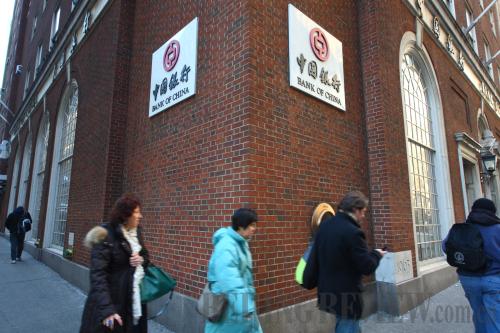|
 |
|
YUAN IN THE U.S.: Pedestrians pass by Bank of China's New York branch, which now allows companies and individuals to buy and sell the yuan (WU KAIXIANG) |
The world's biggest lender by market value, the Industrial and Commercial Bank of China (ICBC), and the Hong Kong-based Bank of East Asia signed an agreement in which ICBC would pay $140.23 million to buy an 80-percent interest in Bank of East Asia USA, the Hong Kong bank said on January 23.
The acquisition will enable ICBC to establish a solid presence in the United States. With a commercial bank license in the United States, ICBC can further expand its retail banking business and operating network and ultimately enhance its market position, ICBC Chairman Jiang Jianqing said.
The successful completion of the transaction will not only establish a good foundation for the provision of holistic financial services by a Chinese mainland bank in the United States, but it will also mark a new era of cooperation between China and the United States and have a positive impact on Sino-U.S. trade relations, Jiang said.
In hopes of expanding of its operations across Europe, ICBC just opened five new branches in major European cities—Amsterdam, Brussels, Paris, Madrid and Milan—in January. The banking giant already has branches in Moscow, London, Frankfurt and Luxembourg.
ICBC is not alone in its recent strides overseas. Bank of China (BOC) also opened branches in Brussels and Dusseldorf in December to meet the momentum of brisk Sino-European economic and trade cooperation. The Chinese banking industry is in the midst of its "going out" strategy, said BOC Chairman Xiao Gang.
An outbound trend
China's integration into the world economy requires its banking industry globalization, said BOC President Li Lihui at the fifth 21st Century Annual Finance Summit of Asia held last November in Beijing.
Chinese enterprises accelerated their "going out" paces after the global financial crisis in 2008. BOC was among them. In general, Chinese banks not only provided capital support for Chinese enterprises' overseas investment, they also helped improve their banking business, achieving a win-win result, said Li.
Banks should provide follow-up financial services for the international operations of enterprises, said Li. In this sense, the Chinese banking industry should also improve its management ideas and levels, and stick to the path of globalized development.
By the end of 2009, Chinese banks had established more than 1,200 overseas branches in 32 countries and regions, said Xiao. The Chinese banking industry's overseas assets totaled more than $270 billion in 2009. That number was only $9 billion in 1985.
Cao Honghui, a researcher with the Institute of Finance and Banking at the Chinese Academy of Social Sciences (CASS), said China's economic restructuring requires expanding both domestic demand and the external market, as well as increasing outward direct investment, and the Chinese yuan also expands its global reach, all of which propelled Chinese banks to branch out.
| 